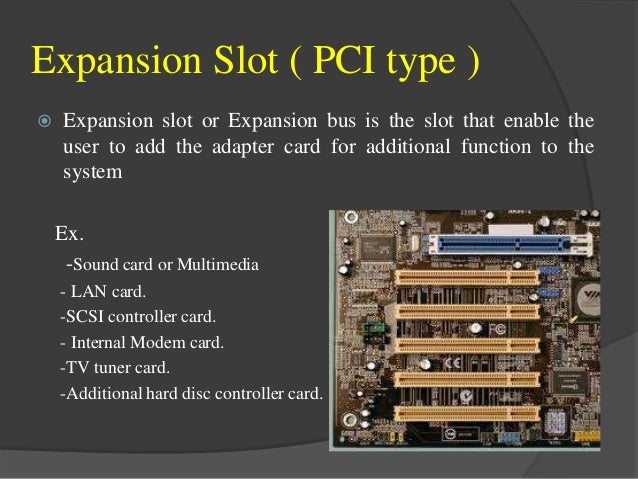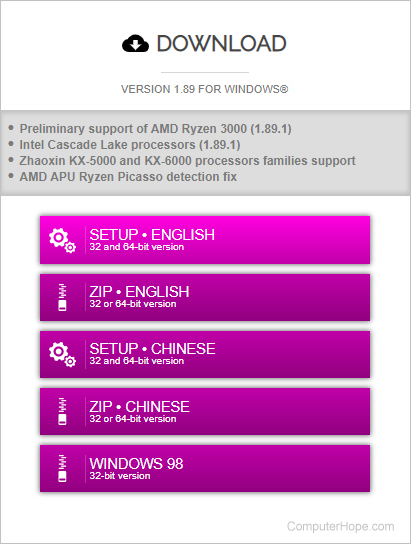Memory Slot Function
PCMCIA is an acronym for Personal Computer Memory Card InternationalAssociation; the acronym is pronounced as separate letters. PCMCIA isa non-profit trade association and standards body consisting of some500 companies. PCMCIA has developed a standard for small, creditcard-sized devices, called PC cards, that are often used in notebookcomputers. (Adapters are available that allow PC cards to be used indesktop computer systems.) You can visit the PCMCIA web site at:
In the past, the cards were known as PCMCIA cards, but they are nowreferred to as PC cards, PC card hosts, and PC card software.PCMCIA refers to the association and standards body.
Dram Memory Slot Function
Memory Slots Located in the upper-right part of the motherboard, the memory slots are used to house the computer’s memory modules. The number of slots can vary, depending on motherboard, from 2, in low-end motherboards, all the way up to 8 memory slots, on high-end and gaming motherboards. Yes you are going to have reduced performance due to the way Dual channel works. For dual channel to work correctly you need have your ram configured one of these 3 ways: slots 1+3, slots 2+4, or slots 1+2+3+4. Some RAM manufacturers make dummy modules to fill in the empty slots to make for a uniform RGB block I don't know if Gskill does or not. Most adults can store between 5 and 9 items in their short-term memory. Miller (1956) put this idea forward and he called it the magic number 7. He though that short-term memory capacity was 7 (plus or minus 2) items because it only had a certain number of “slots” in which items could be stored.
A PC card slot is an expansion slot often found in notebook computersthat allows for the easy and quick addition of a host of differentdevices. Originally designed for adding memory to portablecomputer systems, the PC card standard has been updated several timessince its original creation.
- You mention SD (Secure Digital) cards, so you must mean the SD slot in some laptops. There are two main purposes in putting an SD slot in a computer. One is so that you can take an SD card out of a camera and read it to down load the images withou.
- The Gaming Mode disables the Windows Key function to avoid accidental usage. Furthermore, you can maximize the effect of Anti-Ghosting by activating the Gaming Mode function. You can also choose to disable the Alt + Tab and Alt + F4 functions by changing the Gaming Mode settings in Razer Synapse 3.

PC cards are Plug and Play devices that are often hot-swappable (i.e.,cards may be removed and inserted with the computer power turned on,without rebooting) under Mac OS and Windows 95and beyond. (Windows NT, however, has more limited supportfor PC cards, and you cannot change cards on the fly.) Many systemswill give a familiar beep sound from the computer's speaker when youremove or insert a card.
Differences between PC cards
There are three different types of PC cards. All three have the samerectangular size (85.6 by 54 millimeters), but different thicknesses.
- Type I cards can be up to 3.3mm thick, and are used primarily for addingadditional ROM or RAM to a computer.
- Type II cards (the most common) can be up to 5.5mm thick. Thesecards are often used for modem, fax, SCSI, andLAN cards.
- Type III cards can be up to 10.5mm thick, sufficiently large forportable disk drives.
Differences between PC card slots
As with the physical PC cards, PC slots also come in three sizes:
- A type I slot can hold one type I card
- A type II slot can hold one type II card, or two type I cards
- A type III slot can hold one type III card, or a type I and typeII card.
Most notebook computer systems come with two PC card slots that allowfor the use of two type I or type II PC cards and one type III PCcard. The PC card slots are stacked with one above theother. Usually, type III PC cards fit only in the bottom slot.
Common PC card devices
Following is a list of common PC card devices:

- CD-ROM interface
- Cellular phone interface
- Security tokens
- Docking station interface
- 10Mbps Ethernet LAN adapters
- 100Mbps Ethernet adapters
- GPS (Global Positioning System) cards
- Hard drives
- Infrared wireless LAN adapters
- ISDN cards
- Joystick interface cards
- Memory cards
- Modem and Ethernet combination cards
- Parallel port interface
- SCSI adapters
- Serial port interface
- Sound cards, input and output
- Video capture/frame grabber cards
- Video teleconferencing cards
Cardbus
Many laptop manufacturers now advertise their PC card slots as cardbuscompatible, or they simply identify the slots as cardbusslots. Cardbus is an extension of the latest PCMCIA standard, whichexpands the bus bandwidth and throughput to 32bits at 33MHz. In contrast, the older PC card standard was16 bits at 8MHz. Cardbus is analogous to the PCI slots in desktops,while the older PC card standard is analogous to ISA. The newercardbus slot can accommodate an older 16-bit PC card, but an older PCcard slot cannot accept newer cardbus cards. To tell if your PC cardis cardbus, look on the interface end of the card. Cardbus deviceswill have a notched metal plate on that end.
While not technically accurate, some vendors and technicians refer tothe older style 16-bit PC card as PCMCIA in order to contrast it with32-bit cardbus cards, which makes them sound like competingstandards. However, cardbus is an extension to the PCMCIA standard,not a replacement.
For additional information, see:

ExpressCard
The latest extension of the PCMCIA standard is calledExpressCard. This standard is being built on the latest USB2.0 and PCI Express buses. The aim is to increase speed and reducesize, cost, and complexity. One of the ways it does this is toeliminate the PCMCIA Host Controller in favor of using the USB or PCIExpress controller directly.
For additional information, see:
A memory slot, memory socket, or RAM slot allows RAM (computer memory) to be inserted into the computer. Most motherboards have two to four memory slots, which determine the type of RAM used with the computer. The most common RAM types are SDRAM and DDR for desktop computers and SODIMM for laptop computers, each having various types and speeds. The picture below is an example of what memory slots may look like inside a desktop computer. In this picture, there are three open and available slots for three memory sticks.
When buying a new computer or motherboard, pay close attention to the types of RAM the memory slots can accept. Make sure you know exactly the type of RAM to buy for your computer. It is also important to note how many available memory slots are available in your computer. It is not uncommon for computers to have all memory slots occupied. If all slots are full and you want to upgrade the computer memory, you need to remove some or all of the existing memory.
Why are the memory slots different colors?
When a motherboard has different colored memory slots, it indicates the memory slots are dual-channel, and pairs of memory should be installed on the same channel (color). For example, a motherboard could have two yellow and two black memory slots. The yellow memory slots could indicate Channel A and Channel B could be indicated by the black slots. If you were only installing two memory sticks, you'd want to install both of them in Channel A (yellow slots) for optimal performance.
Ram Memory Slot Function
Related pages
Memory Slot Function
Memory module, Memory terms